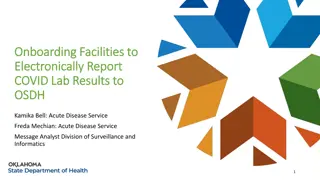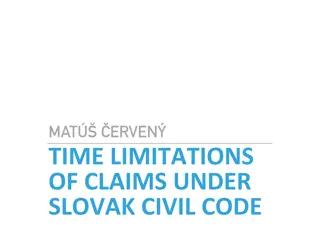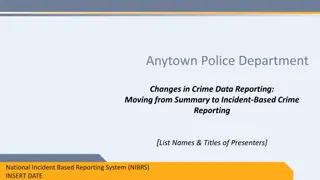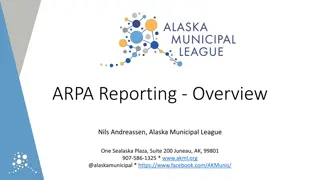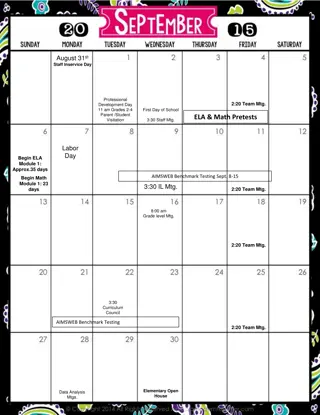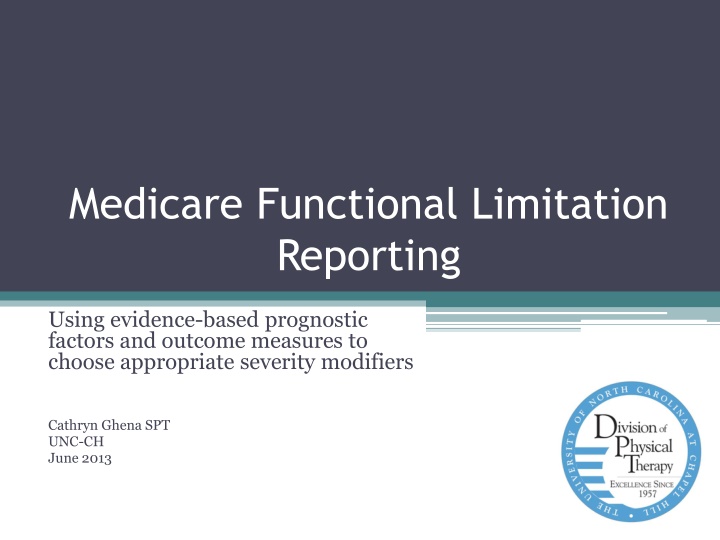
Medicare Functional Limitation Reporting - Evidence-Based Approach for Clinical Judgement
Learn how to identify functional assessment tools, interpret outcome measures, and use prognostic factors effectively for Medicare G-codes. Explore severity modifiers and choose appropriate measures for patients in acute care settings.
Download Presentation

Please find below an Image/Link to download the presentation.
The content on the website is provided AS IS for your information and personal use only. It may not be sold, licensed, or shared on other websites without obtaining consent from the author. If you encounter any issues during the download, it is possible that the publisher has removed the file from their server.
You are allowed to download the files provided on this website for personal or commercial use, subject to the condition that they are used lawfully. All files are the property of their respective owners.
The content on the website is provided AS IS for your information and personal use only. It may not be sold, licensed, or shared on other websites without obtaining consent from the author.
E N D
Presentation Transcript
Medicare Functional Limitation Reporting Using evidence-based prognostic factors and outcome measures to choose appropriate severity modifiers Cathryn Ghena SPT UNC-CH June 2013
Objectives 1. Clinicians will be able to correctly identify and utilize appropriate functional assessment tools for patients in the acute care setting based on diagnosis and impairment. 2. Once functional measures have been correctly identified, scored and interpreted, clinicians will be able to translate their findings to Medicare s G-codes. 3. Clinicians will be able to identify common prognostic factors to use in combination with outcome scores to make accurate clinical judgment for interpretation of impairment severity.
1, 2 G Codes: Review What: Why: Who: When: Functional limitation reporting Reimbursement from Medicare Medicare Patients 1) Evaluation 2) Re-evaluation, and 3) Discharge
Severity Modifiers 1, 2 CN: 100 % impaired CM: 80-99% impaired CL: 60-79% impaired CK: 40-59% impaired CJ: 20-39% impaired CI: 1-19% impaired CH: 0% impaired
1, 2 But how do you choose? 2) Objective Info 1) Outcome Measures 3) Patient profile
1, 2, 3 Evidence Based Practice CBOR Conversion Calculator PT Now: Identified Measures Using psychometric properties
1, 3 So what measures should I use? ACUTE AM-PAC* CARDIOPULM 10 Meter Walk Test STROKE 2 Min Walk Test 10 Meter Walk Test Functional Reach Orpington Prognostic 10 Meter Walk Test 2 Min Walk Test RPE 2 Min Walk Test KUH Elderly Mobility Scale Scale* LEFS FIM* Stroke Impact Scale* TUG* ORTHO BALANCE/GAIT OCC. THERAPY Hip Outcome Sore Harris Hip KOS-ADLs Tinetti* FAM* FIM* Comfortable Gait Speed Fast Gait Speed 10 Meter Walk Test Tinetti Falls Efficacy LEFS* Scale TUG*
1, 3 Acute Measures AM-PAC* 10 Meter Walk Test 2 Min Walk Test KUH Elderly Mobility Scale* LEFS* FIM*
4 General Acute Care Prognostic Factors Systemic inflammation (Smith 2013) Cognitive limitations (Smith 2013) Prolonged mechanical ventilation (Smith 2013) Increased aged (Smith 2013) Severe acute respiratory distress syndrome (Smith 2013) Past history of hospitalization (Smith 2013)
1, 3 Cardiopulmonary Measures 10 Meter Walk Test RPE 2 Min Walk Test
COPD Prognostic Factors 5, 6, 7, 17 Malnutrition (Schworm 2011) Decreased BMI(Ranieri 2008) COPD exacerbation combined with cardiac history/event (Steer 2010) Decreased ability to perform IADLs (Ranieri 2008) Low Barthel Index (Ranieri 2008) Severity of exacerbation (Ranieri 2008) Low BODE index (Celli 2004)
8 Cardiovascular Risk Factors Family Hx of CAD/MI Age >65 Gender: men vs women Smoking Diabetes Hyperlipedemia Sedentary lifestyle Obesity High Blood pressure
Stroke Measures 1, 3, 15, 18 2 Min Walk Test 10 Meter Walk Test Functional Reach Orpington Prognostic Scale* Stroke Impact Scale* TUG*
9 Stroke Prognostic Factors Prior h/o stroke Abnormal tone Loss of sitting balance Sensory deficits Incontinence Depression/lack of support Visual spatial deficits Cognitive deficits
1, 3, 15 Orthopedic Outcome Measures Hip Outcome Sore Harris Hip KOS-ADLs LEFS*
10, 11, 12 Orthopedic Prognostic Factors Low hemoglobin post surgery (Diamond 2004) Prolonged periods under anesthesia (Bo 2007) Multiple comorbidities (Bo 2007) Increased dependence for ADLs prior to sx (Bo 2007) DVTs (Bell 2011) Infection post sx (Bell 2011)
1, 3, 13, 15 Gait/Balance Measures Tinetti* Comfortable Gait Speed Fast Gait Speed 10 Meter Walk Test TUG*
13, 14. 15, 16 Gait Speed
1, 3, 15 Occupational Therapy Measures FAM* FIM* Tinetti Falls Efficacy Scale
References 1. Functional limitation reporting under medicare. PT Now: Tools for Advancing Physical Therapist Practice Web site. http://www.ptnow.org/FunctionalLimitationReporting/Default.aspx. Published 2013. Updated 2013. Accessed June 6, 2013. West, P. (2012, Dec) Preparing for Therapy Required Functional Reporting Implementation in CY 2013. PPT presented by CMS. MediServe claims-based outcomes reporting conversion calculator. MediServe: A Mediware Company Web site. http://www.mediserve.com/resource/analysis/cbor-conversion/. Updated 2013. Accessed June 7, 2013. Smith J, Ohtake P. Critical illness: Managing patients in the intensive care unit. PTNow Web site. http://www.ptnow.org/ClinicalSummaries/QuickDetail.aspx?cid=9d2691f3-b5df-45a9-ac2d-97f7935c746f. Published 2013. Updated 2013. Accessed June 10, 2013. Ranieri P, Bianchetti A, Margiotta A, Virgillo A, Clini EM, Trabucchi M. Predictors of 6-month mortality in elderly patients with mild chronic obstructive pulmonary disease discharged from a medical ward after acute nonacidotic exacerbation. J Am Geriatr Soc. 2008;56(5):909-913. doi: 10.1111/j.1532-5415.2008.01683.x; 10.1111/j.1532-5415.2008.01683.x. Steer J, Gibson GJ, Bourke SC. Predicting outcomes following hospitalization for acute exacerbations of COPD. QJM. 2010;103(11):817-829. doi: 10.1093/qjmed/hcq126; 10.1093/qjmed/hcq126. Celli BR, Cote CG, Marin JM, et al. The body-mass index, airflow obstruction, dyspnea, and exercise capacity index in chronic obstructive pulmonary disease. N Engl J Med. 2004;350(10):1005-1012. doi: 10.1056/NEJMoa021322. Crouch, R. (2012, May). Cardiovascular Risk Factors. PPT presented in Bondurant Hall in University of North Carolina at Chapel Hill. Mercer, V. (2013, Sept) Predictors of Outcomes in Stroke. PPT presented in Bondurant Hall in University of North Carolina at Chapel Hill. Diamond PT. Severe anaemia: Implications for functional recovery during rehabilitation. Disabil Rehabil. 2000;22(12):574-576. Bell K, Shovestul A. Total knee arthroplasty. PT Now: Tools for Advancing Physical Therapist Practice Web site. http://www.ptnow.org/ClinicalSummaries/QuickDetail.aspx?cid=96cc5bc9-263e-4b40-b388-a9b086981640. Published October 25, 2011. Updated 2011. Accessed June 6, 2013. Braden HJ, Hilgenberg S, Bohannon RW, Ko MS, Hasson S. Gait speed is limited but improves over the course of acute care physical therapy. J Geriatr Phys Ther. 2012;35(3):140-144. doi: 10.1519/JPT.0b013e31824baa1e; 10.1519/JPT.0b013e31824baa1e. Duncan, P. (2012, Oct). Walking Speed: the 6th Vital Sign. PPT presented in Bondurant Hall in University of North Carolina at Chapel Hill. Rabadi MH, Blau A. Admission ambulation velocity predicts length of stay and discharge disposition following stroke in an acute rehabilitation hospital. Neurorehabil Neural Repair. 2005;19(1):20-26. doi: 10.1177/1545968304272762. Heinemann A. Rehabilitation measures database. Rehabilitation Institute of Chicago Web site. http://www.rehabmeasures.org/default.aspx. Published 2012. Updated 2013. Accessed June 5, 2013. Steffen T, Seney M. Test-retest reliability and minimal detectable change on balance and ambulation tests, the 36-item short-form health survey, and the unified parkinson disease rating scale in people with parkinsonism. Phys Ther. 2008;88(6):733-746. doi: 10.2522/ptj.20070214; 10.2522/ptj.20070214. Schworm K. Chronic obstructive pulmonary disease. PT Now: Tools for Advancing Physical Therapist Practice Web site. http://www.ptnow.org/ClinicalSummaries/QuickDetail.aspx?cid=d23c6734-bd0e-46a4-9109-92130fb6855f. Published October 01, 2011. Updated 2011. Accessed June 05, 2013. Sullivan J, Zipp G. StrokEDGE outcome measures for acute care. APTA: The Neurology Section Web site. http://www.neuropt.org/special-interest- groups/stroke/strokedge. Updated 2011. Accessed June 10, 2013. 2. 3. 4. 5. 6. 7. 8. 9. 10. 11. 12. 13. 14. 15. 16. 17. 18.
References cont. 1. Montero-Odasso M, Schapira M, Soriano ER, et al. Gait velocity as a single predictor of adverse events in healthy seniors aged 75 years and older. J Gerontol A Biol Sci Med Sci. 2005;60(10):1304-1309. Rabadi MH, Blau A. Admission ambulation velocity predicts length of stay and discharge disposition following stroke in an acute rehabilitation hospital. Neurorehabil Neural Repair. 2005;19(1):20-26. doi: 10.1177/1545968304272762. Ranieri P, Bianchetti A, Margiotta A, Virgillo A, Clini EM, Trabucchi M. Predictors of 6-month mortality in elderly patients with mild chronic obstructive pulmonary disease discharged from a medical ward after acute nonacidotic exacerbation. J Am Geriatr Soc. 2008;56(5):909-913. doi: 10.1111/j.1532-5415.2008.01683.x; 10.1111/j.1532- 5415.2008.01683.x. Scherer SA, Hammerich AS. Outcomes in cardiopulmonary physical therapy: Acute care index of function. Cardiopulm Phys Ther J. 2008;19(3):94-97. Schworm K. Chronic obstructive pulmonary disease. PT Now: Tools for Advancing Physical Therapist Practice Web site. http://www.ptnow.org/ClinicalSummaries/QuickDetail.aspx?cid=d23c6734-bd0e-46a4-9109-92130fb6855f. Published October 01, 2011. Updated 2011. Accessed June 05, 2013. Smith J, Ohtake P. Critical illness: Managing patients in the intensive care unit. PTNow Web site. http://www.ptnow.org/ClinicalSummaries/QuickDetail.aspx?cid=9d2691f3-b5df-45a9-ac2d-97f7935c746f. Published 2013. Updated 2013. Accessed June 10, 2013. Steer J, Gibson GJ, Bourke SC. Predicting outcomes following hospitalization for acute exacerbations of COPD. QJM. 2010;103(11):817-829. doi: 10.1093/qjmed/hcq126; 10.1093/qjmed/hcq126. Steffen T, Seney M. Test-retest reliability and minimal detectable change on balance and ambulation tests, the 36-item short-form health survey, and the unified parkinson disease rating scale in people with parkinsonism. Phys Ther. 2008;88(6):733-746. doi: 10.2522/ptj.20070214; 10.2522/ptj.20070214. Sullivan J, Zipp G. StrokEDGE outcome measures for acute care. APTA: The Neurology Section Web site. http://www.neuropt.org/special-interest-groups/stroke/strokedge. Updated 2011. Accessed June 10, 2013. West, P. (2012, Dec) Preparing for Therapy Required Functional Reporting Implementation in CY 2013. PPT presented by CMS. 2. 3. 4. 5. 6. 7. 8. 9. 10.






